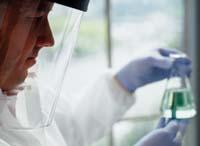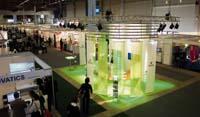Nanoparticles: small but not banal

For example, genetically modified organisms, which have been produced for a long time and are increasingly consumed, continue to generate a contrary position in much of society. Now it seems that products made with nanotechnology can have a similar response. This is evidenced by, for example, the competition held in 2006 by the ETC Group and the press releases published earlier this year by the British entity Soil Association or Lurra.
The ETC Group is a Canadian environmental association that for two years has launched a competition to create a special label for products with nanoparticles. It was quite successful: in a few months they received almost five hundred proposals.
Soil Association is a British association. He is in favor of organic foods and in a press release stating that they do not use or use nanotechnologies in their products. Moreover, the first organization that does not accept nanoparticles.

According to them, there are still few studies on the influence of nanoparticles on living organisms, so it is better not to use them until the results are clear. In addition, they have denounced the British government for not taking measures against products generated by nanotechnology and for putting commercial interests above the health of citizens.
However, the British government has spent years researching the effects of nanoparticles and in 2004 requested their non-use until their consequences were clarified. However, they do not have specific regulations. However, this is not only happening in Britain, but throughout the European Union and the United States, among other things, we are working to solve the problem.
And steps are already being taken: In February, the US government published its strategy to investigate the effects of nanotechnology on environmental, health and safety issues. On the other hand, the European Union has developed a code of conduct for the responsible use of nanotechnology, which has asked member states to convert this voluntary code into a regulation. Among his proposals in the code it is mentioned that nanoscience must be safe and ethical and meet the best standards of science.
In addition, the food security organization in the European Union, EFSA, is preparing a report on the risks of nanotechnology in food and food, in collaboration with scientists working in this field. The interim report is expected to leave in July and the final in autumn.

Small and different
It cannot be denied that certain nanotechnology products can pose a risk to health and the environment. Nanoparticles have 100 nanometers or less (viruses measure between 50 and 100 nanometers; proteins between 2 and 8 nanometers) and can present very different characteristics than those of a substance to a greater extent. Nanotechnology is used to create new products and applications. But they also run the risk of causing damage, both due to their characteristics and size.
Free nanoparticles are particularly concerned. Igor Campillo, director of development and communication at CIC nanoGUNE, tells us that nanostructures that are part of a large object are not dangerous, at least more dangerous than conventional materials. In any case, they can reach their environment after use if not treated properly. Free nanoparticles, even those found in clusters, are easily accessible to the environment and can penetrate living organisms. Several studies have shown that some nanoparticles have the ability to penetrate tissues and membranes, which can have a harmful effect inside the cells.

However, before reaching living organisms, researchers have many questions to answer. As with any other compound, the potential impact of nanoparticles can be positive, unfavorable or neutral depending on factors such as toxicity, bioavailability, mobility, stability, solubility and reactivity.
Diverse particles, multiple effects
So far, most studies have focused on measuring the effects of ultrafine particles (UFP). These particles, of a diameter of less than 100 nanometers, can be natural or man-made, often involuntarily: in industry, diesel engines, other combustions, volcanoes, detached from the ground, etc.
Ultrafine particles remain in the air and the wind can take them far. The large surface can carry contaminants, oxidizing gases, organic compounds and transition metals adsorbed on the surface. Moreover, it can react with other elements present in the atmosphere, leading to the formation of new particles of very different reactivity and characteristics.

Nanoparticles are very similar to ultrafine particles. Their size is similar, and the biggest difference is that they are those created by man in certain processes and not by chance. Otherwise, they behave similarly. Therefore, together with the development of nanotechnology it is essential to know the influence of nanoparticles. To do this, researchers need to look for new ways, not only to measure impact, but also for the detection and monitoring of nanoparticles, since conventional detection methods do not serve to detect nanoparticles.
From laboratory to industry
This topic has already been addressed in Euskal Herria. CIC nanoGUNE will coordinate the activities of companies dedicated to nanotechnology in the Basque Country and, although it has not yet been launched, CIC nanoGUNE is clear that it will focus on two aspects: on the one hand, on the security control of products generated by nanotechnology for medical applications and, on the other, on the realization of an observatory of nanosegmentation.

According to Igor Campillo, one of the main functions of this observatory will be the monitoring of projects that analyze the impact of nanoparticles and products through nanotechnology on health and the environment. In addition, they plan to create working protocols with nanomaterials and nanoparticles. The issue is that as nanotechnology develops, it moves from laboratories to industry. By then, it is convenient to have protocols to ensure the safety of workers and consumers of products.
Currently there are companies that use nanotechnology, such as Inasmet-Tecnalia, Gaiker-IK4 or LEIA-IK4, which take security and prevention into account. LABEIN-Tecnalia as the VI European Union R&D Congress. Participates in the SAPHIR project included in the Framework Program. The aim of this project is to develop a nanomaterial production plant.
This workshop will cover the entire nanomaterial production chain (production, recovery, adaptation and recycling). In the words of Yolanda de Miguel, head of the LABEIN-Tecnalia project, the keys to the workshop will be competitiveness and, above all, ensuring safety at all points. In this way a method is being created that ensures that nanoparticles are not lost.
To demonstrate the effectiveness of the SAPHIR project, through nanotechnology and completely safely, they will create high-value-added products: automotive lights, more resistant materials for aeronautics, fuel cells for energy and self-cleaning walls for construction.



Buletina
Bidali zure helbide elektronikoa eta jaso asteroko buletina zure sarrera-ontzian










